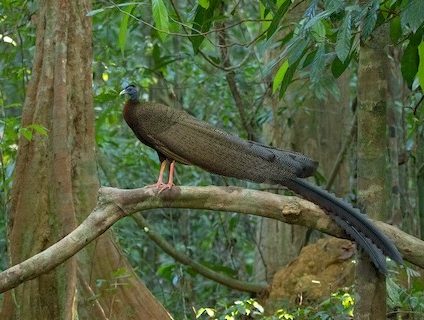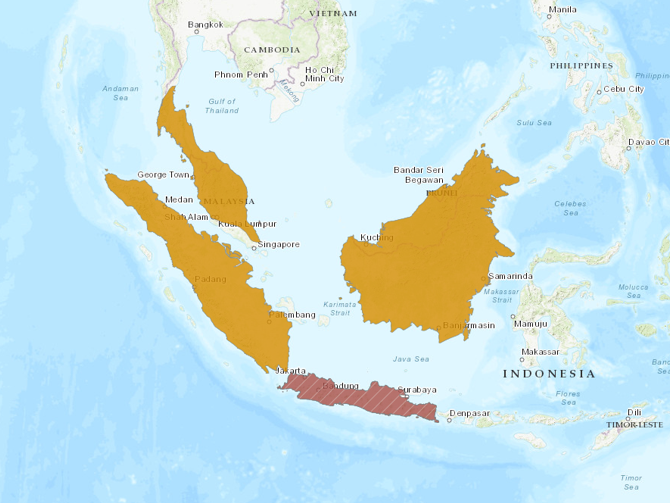Birdfinding.info ⇒ Shy and elusive, and therefore rarely seen, but its distinctive, far-carrying calls are often heard in forests of peninsular Malaysia, northern Sumatra, and northern Borneo. In Thailand, it can be found north of Phuket at Khao Sok National Park and along the Malaysian border at Thale Ban National Park. In Malaysia, it most easily found at Taman Negara National Park, but can also be found close to Singapore at Gunung Panti Forest Reserve. In Sabah, the Borneo Rainforest Lodge in the Danum Valley is the most accessible reliable site for the grayi subspecies.
Great Argus
Argusianus argus
The Malay Peninsula, Sumatra, and Borneo, where it inhabits humid tropical forests from lowlands up to about 1,300 m elevation.
Populations persist in most remaining areas of extensive forest on Sumatra and the Malay Peninsula north to Lenya National Park in southern Myanmar.
On Borneo, it occurs nearly throughout the Malaysian territories. In Kalimantan it appears to be more localized—most reports are from East Kalimantan.
As of 2016, the global population was estimated at >100,000.
Identification
A large, brown pheasant with a mostly bare blue head, pale bill, and pink legs. The male’s head is pastel-blue, with a bold, black “mohawk” crest. Most of the plumage is intricately textured with fine bars and spots.
The male has extraordinarily long, broad tail-feathers and secondaries, which transform its overall appearance. The two central tail feathers grow to approximately 1.5 m—nearly three-quarters of the bird’s total length.
Even more extraordinary are the elongated secondaries, which exceed 50 cm. When the wings are folded, they give the impression of a cylindrical carapace.
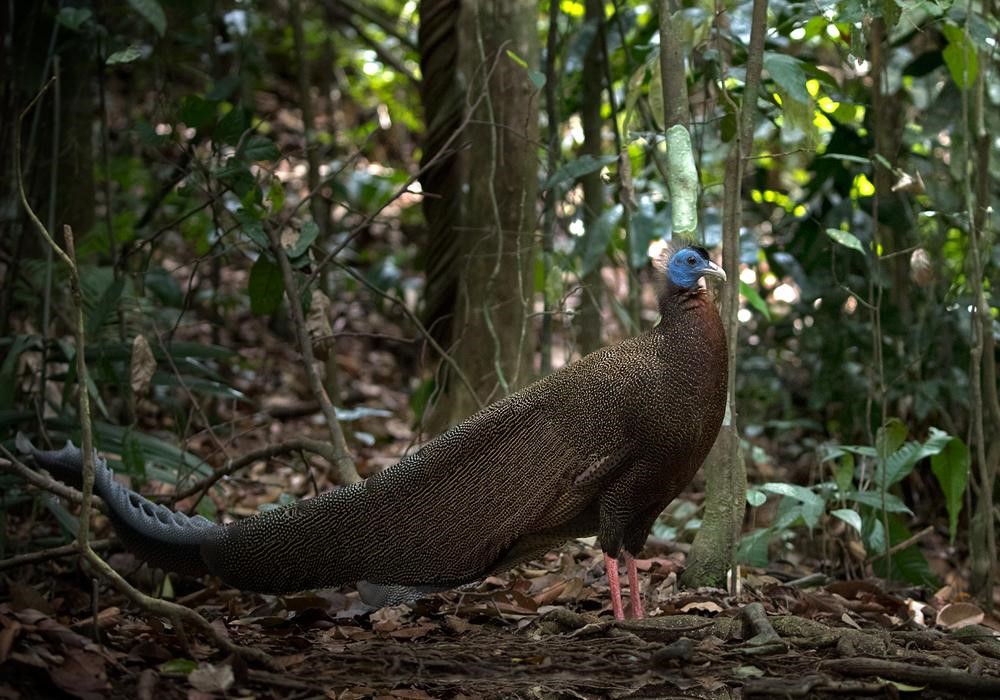
Great Argus, male standing proudly. (Gunung Leuser National Park, Sumatra, Indonesia; May 6, 2019.) © Lars Petersson
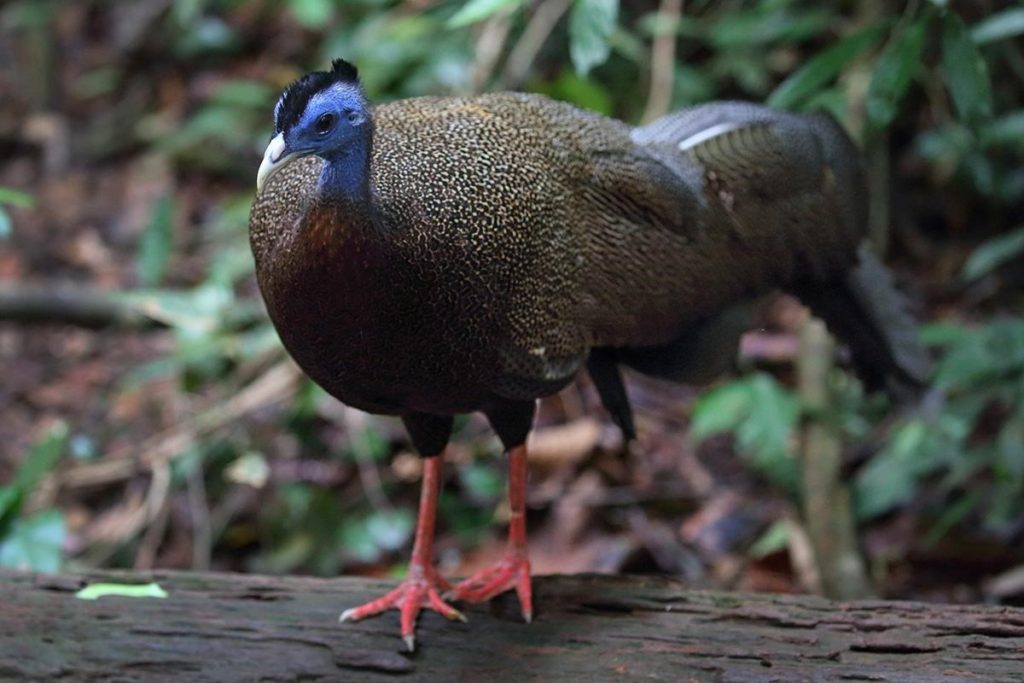
Great Argus, male showing blue head with black mohawk, and coral-pink legs. (Gunung Leuser National Park, Sumatra, Indonesia; May 17, 2017.) © Björn Svensson
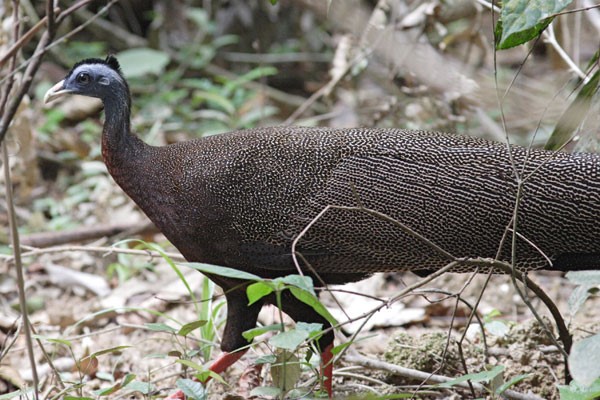
Great Argus, male. (Taman Negara National Park, Kuala Tahan, Malaysia; February 4, 2006.) © John & Jemi Holmes
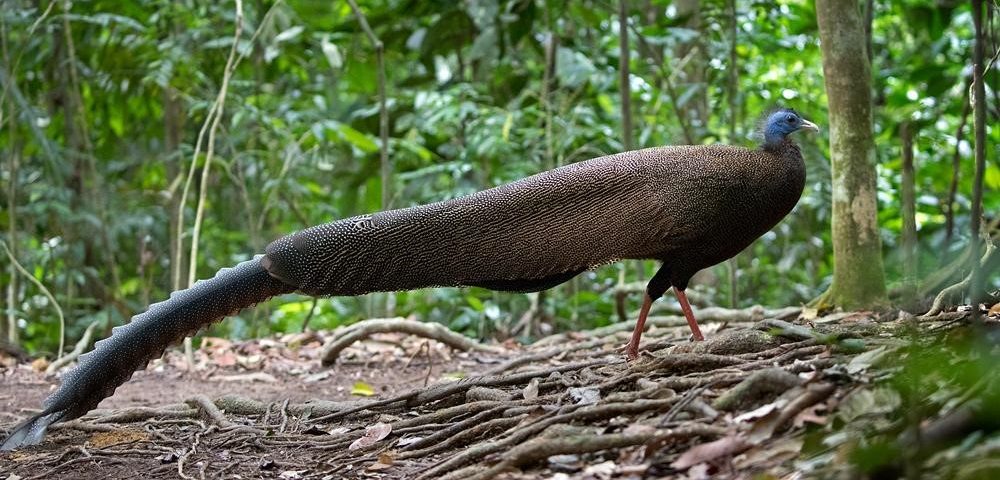
Great Argus, male showing the full length of its tail and wings. (Gunung Leuser National Park, Sumatra, Indonesia; May 6, 2019.) © Lars Petersson
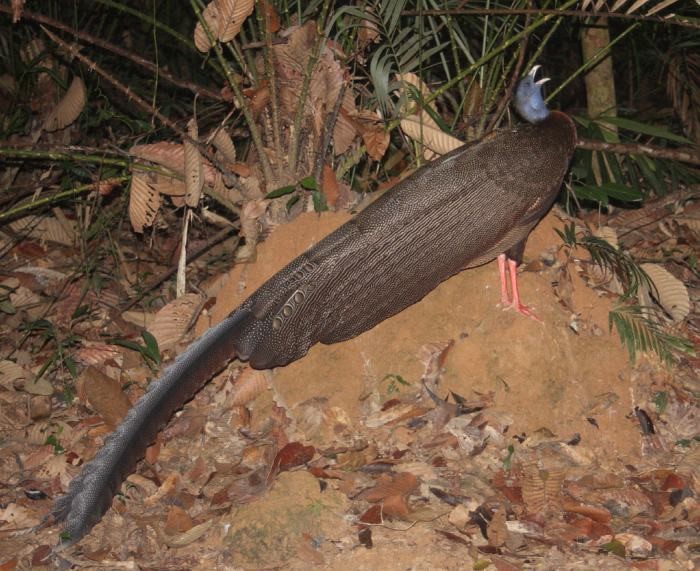
Great Argus, male calling, and showing the extraordinary elongation of its tail feathers and secondaries. (Taman Negara National Park, Kuala Tahan, Malaysia; February 26, 2009.) © David Free
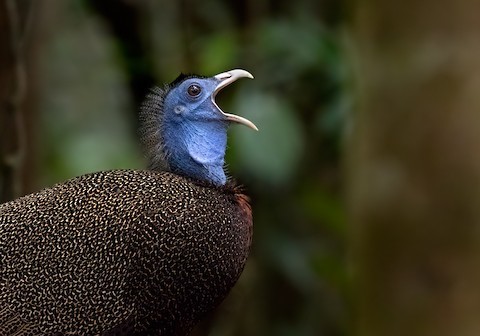
Great Argus, male calling. (Gunung Leuser National Park, Sumatra, Indonesia; May 6, 2019.) © Lars Petersson
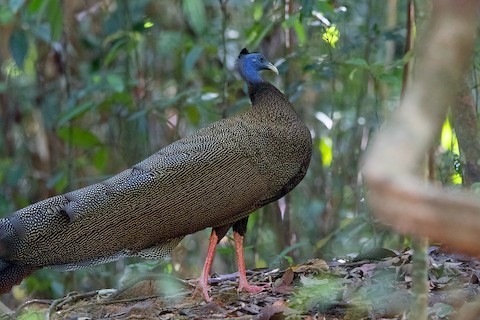
Great Argus, male. (Thale Ban National Park, Satun, Thailand; May 3, 2019.) © Ayuwat Jearwattanakanok
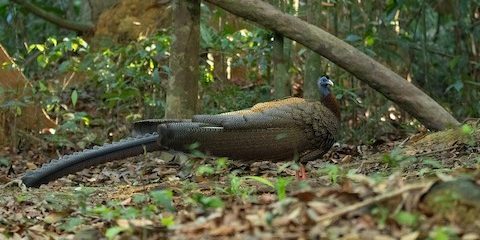
Great Argus, male showing buffy back. (Thale Ban National Park, Satun, Thailand; May 3, 2019.) © Ayuwat Jearwattanakanok
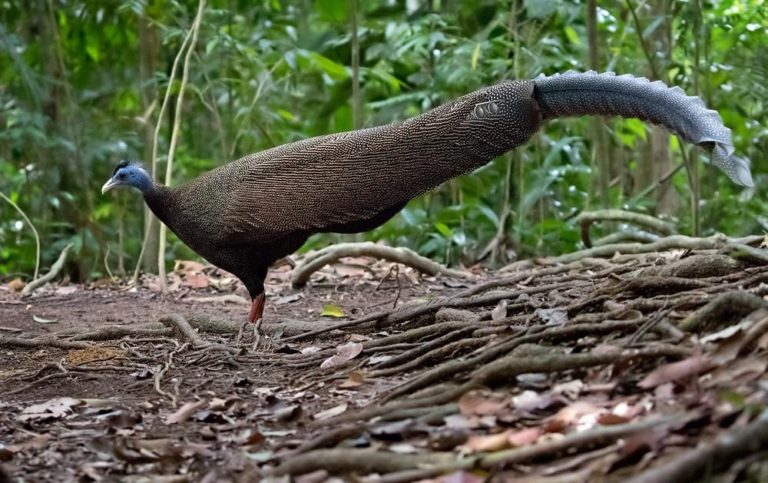
Great Argus, male—note grayish, rippled tail feathers. (Gunung Leuser National Park, Sumatra, Indonesia; May 6, 2019.) © Lars Petersson
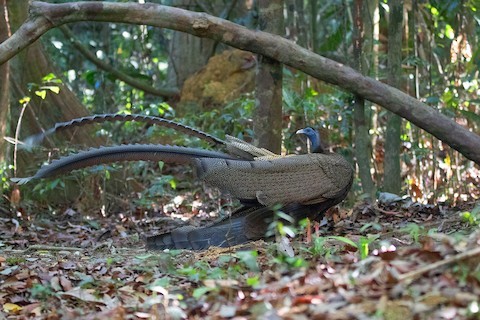
Great Argus, male spreading its tail feathers. (Thale Ban National Park, Satun, Thailand; May 3, 2019.) © Ayuwat Jearwattanakanok
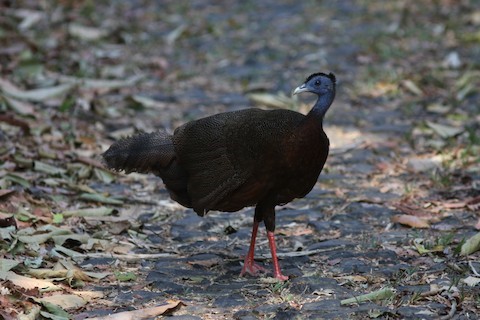
Great Argus, young male. (Way Kambas National Park, Lampung, Sumatra, Indonesia; November 8, 2019.) © Robert Maxfield
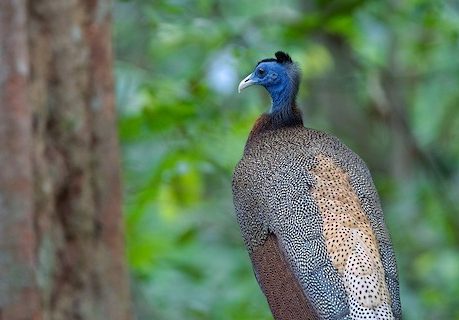
Great Argus, male showing buffy back with black spots. (Thale Ban National Park, Satun, Thailand; May 3, 2019.) © Ayuwat Jearwattanakanok
The two subspecies differ significantly in certain parts of their body coloration. The nominate subspecies, of Sumatra and the Malay Peninsula, has a rufous-brown chest, and its back is mostly pale buffy with black spots. The Bornean subspecies grayi is bright-rufous brown on both the breast and the back.
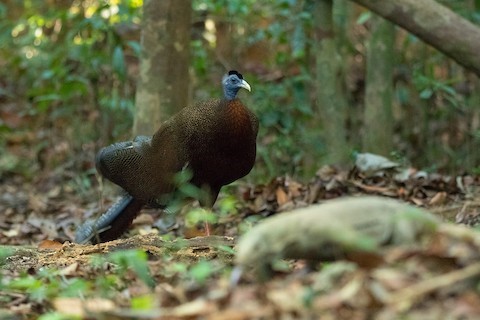
Great Argus, male showing rusty-brown chest. (Thale Ban National Park, Satun, Thailand; May 3, 2019.) © Ayuwat Jearwattanakanok
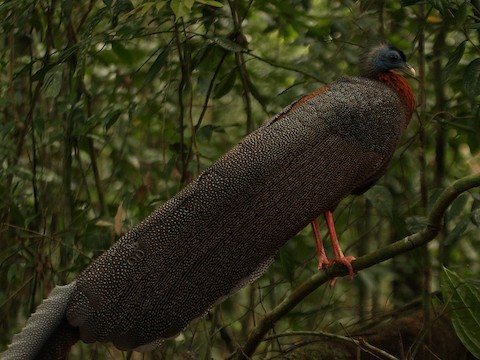
Great Argus, A. a. grayi, male, showing some of the extensively chestnut body plumage typical of this subspecies. (Danum Valley, Sabah, Borneo, Malaysia; August 9, 2009.) © Wayne Hsu
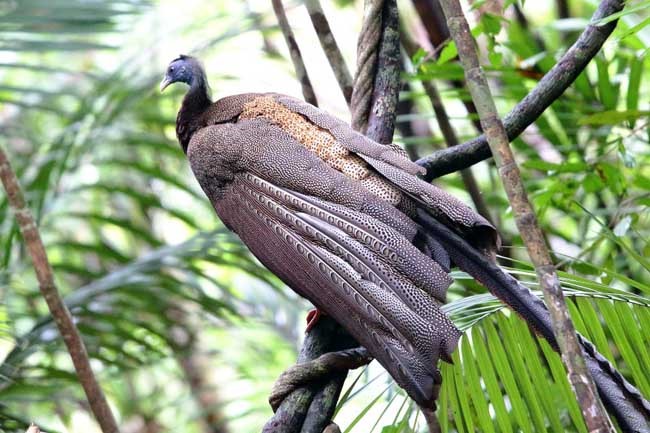
Great Argus, male showing buffy back with black spots. (Taman Negara National Park, Kuala Tahan, Malaysia; May 11, 2014.) © Rosli Omar
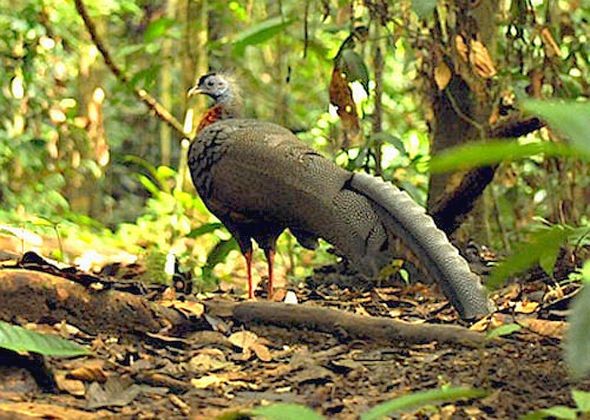
Great Argus, A. a. grayi, male. (Danum Valley, Sabah, Borneo, Malaysia; January 2, 2009.) © Jason Bugay Reyes
Females resemble males but lack the disproportionate wing and tail-feathers. Their heads are plainer than the male’s, appearing bluish with sparse grayish feathers, and lacking the distinct black mohawk.
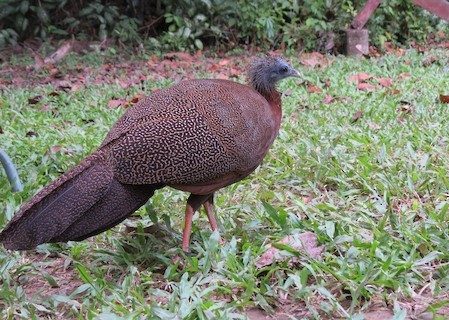
Great Argus, female. (Taman Negara National Park, Kuala Tahan, Malaysia; January 30, 2016.) © Tom Wheatley
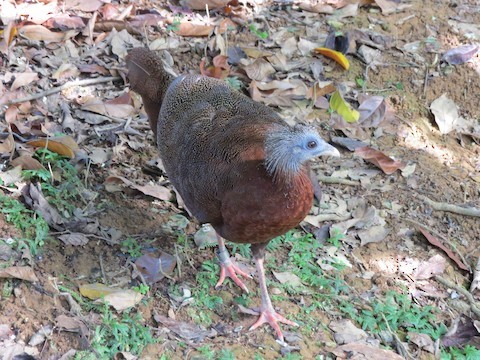
Great Argus, female. (Taman Negara National Park, Kuala Tahan, Malaysia; January 27, 2016.) © Tom Wheatley
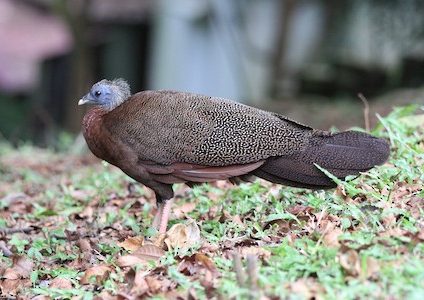
Great Argus, female. (Taman Negara National Park, Kuala Tahan, Malaysia; August 12, 2016.) © Christoph Moning
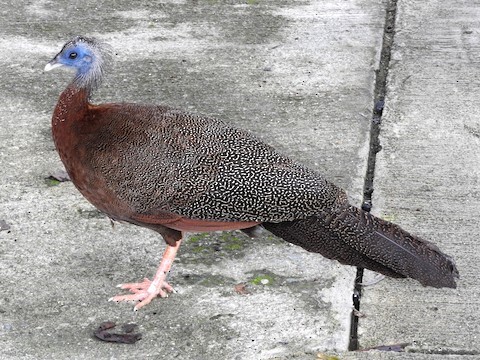
Great Argus, female. (Taman Negara National Park, Kuala Tahan, Malaysia; May 27, 2018.) © Todd A. Watkins
Voice. Gives two types of distinctive, loud calls. One is a liquid note repeated at brief (<1 second) intervals. As the series progresses, the tone rises and the notes become increasingly inflected: Kinabatangan River, Sabah, Malaysia; September 26, 2008. © Filip Verbelen
The other is a series of paired liquid notes repeated at intervals of about 6 to 10 seconds: Sabah, Malaysia. © Frank R. Lambert
Cf. Crested Argus. The two arguses overlap in Malaysia’s Taman Negara National Park and could be mistaken for one another if not seen well—especially the females, which are similar in overall size, shape, and color.
Males of the two species share approximately the same size and shape, although Crested’s tail is longer and broader and its wing-feathers are less elongated than Great’s. In overall coloration, Crested appears paler, grayer, and more noticeably spotted, while Great appears darker, browner, and more uniform. Their heads are more obviously different, as Crested’s is feathered and has a broad, blackish mask framed by a white eyebrow and throat, whereas Great’s is mostly bare and blue.
Females are less conspicuously different. Both are warm-brown overall, with rusty tones on the neck and breast. However, the female Crested has widely spaced rows of dark-bordered white spots on its wings and tail, whereas female Great appears more uniform on the wings and tail. The heads of the females differ in the same way as the males’ heads except that in both species that female’s head coloration is less distinct than the male’s.
Notes
Polytypic species consisting of two recognized subspecies that are readily distinguishable: argus of Sumatra and the Malay Peninsula, and grayi of Borneo.
IUCN Red List Status: Near Threatened.
References
BirdLife International. 2016. Argusianus argus. The IUCN Red List of Threatened Species 2016: e.T22725006A94883506. https://dx.doi.org/10.2305/IUCN.UK.2016-3.RLTS.T22725006A94883506.en. (Accessed March 21, 2020.)
eBird. 2020. eBird: An online database of bird distribution and abundance. Cornell Lab of Ornithology, Ithaca, N.Y. http://www.ebird.org. (Accessed March 21, 2020.)
Madge, S., and P.J.K. McGowan. 2002. Pheasants, Partridges, and Grouse: A Guide to the Pheasants, Partridges, Quails, Grouse, Guineafowl, Buttonquails, and Sandgrouse of the World. Princeton University Press, Princeton, N.J.
McGowan, P.J.K. and G.M. Kirwan. 2020. Great Argus (Argusianus argus). In: del Hoyo, J., Elliott, A., Sargatal, J., Christie, D.A. & de Juana, E. (eds.). Handbook of the Birds of the World Alive. Lynx Edicions, Barcelona. https://www.hbw.com/node/53520. (Accessed March 21, 2020.)
Robson, C. 2002. Birds of Thailand. Princeton University Press, Princeton, N.J.
